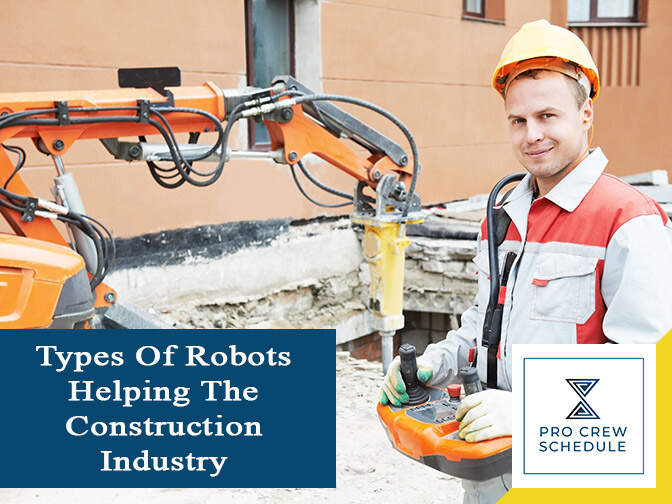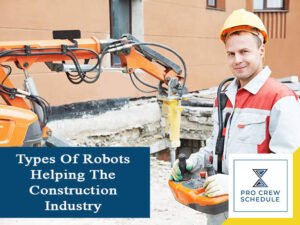Construction has always been one of the biggest industries focused on manual-intensive labor. Construction workers are tasked to do almost everything on-site, from heavy-duty lifting to climbing scaffolding. Consequently, it is also the least digitized and automized industry today. It’s true that some large machinery, like cranes and bulldozers, have been introduced, the crew still operate them.
Nevertheless, several construction innovations have popped up in the 21st century that prove to help the workers and reshape the industry. One of the more straightforward examples is project management software. In the past, project managers and contractors relied on the old pen and paper to stay on top of things. Today, however, with platforms like Pro Crew Schedule, they can store important documents, oversee the whole project, and even keep track of their crew through a builder schedule. Tools like this have improved the efficiency of building projects.
Besides, technology has come a long way and has given the world various robots designed for various tasks and purposes. Even though the human labor factor will always be at the center of this industry, robotics are slowly creeping their way into the industry. Although they are not exactly what people of the past expected, they are gradually getting there and have made several contributions to what the industry is today.
Robotic Contributions to the Construction Industry
a. Safety
It’s a known fact that construction if one of the most dangerous industries to work in. More than 30% of fatal work accidents result from falling, one of construction’s “Fatal Four.” Moreover, due to heavy lifting, many construction laborers have been experiencing severe pains and aches throughout their bodies, mainly on their necks and backs.
But because robots have been incorporated in projects onsite, worker safety has improved. These robots can take over the repetitive and mundane tasks that cause overexertion and stress injuries among workers.
Tybot is an example of how repetitive tasks have become automated. Traditionally, workers are tasked to tie rebar in the construction of bridges while suspended in the air. But Tybot has taken over that job and workers only have to frame about 10% of the bridge themselves before the machine finishes the rest autonomously.
b. Productivity and Efficiency
Two of the most significant impacts robotic technology has on construction are on productivity and efficiency. As construction work relies heavily on humans’ manual labor, the tasks’ completion time tends to take longer than desired. Even if a project is run with the best construction management software, it could still face a few delays and issues due to human errors and speed.
However, with the introduction of robots, construction work has only bee getting faster and better. Wall building is just one task robots can do. Workers have to feed the machine bricks or blocks and the robot does all the work with precision.
SAM100 (Semi-Automated Mason) by Construction Robotics is the first bricklaying robot commercially available for on-site masonry construction. On their website, the machine increases productivity by up to five times and reduces heavy lifting by more than 80%.
Types of Construction Robots
- Industrial
Industrial robots in construction aid in the actual building of structures, working in three or more axes. They are commonly programmed to perform repetitive tasks.
a. Collaborative robots
To work, collaborative robots, or “cobots” in short, need direct human interaction. They are designed to work with humans, doing things that would generally be too difficult or would take too long if done alone by either man or machine.
Even with a significant construction schedule software, the labor shortage is an ongoing construction industry problem. As a solution, cobots can do low-skilled work and might soon replace human laborers.
b. Articulated Robots
Articulated robots are usually seen in manufacturing. Because they look like a human arm, they can be used for diverse applications– from tasks as simple as assembling to more complex ones like welding.
These machines typically have at least four to six axes, but can a maximum of 10. Because of this, they have more degrees of freedom compared to other robots. Consequently, this a popular robot on the market as it gives users more versatility with tasks.
Articulated robots are manufactured by many companies like FANUC, Universal Robots, and Motoman.
c. Gantry Robots
Also known as linear or cartesian robots, gantry robots are built with a manipulator set up on a horizontal overhead plane and use a three-axis system of cartesian coordinates.
This type of structure on robots has various purposes, commonly picking up, carrying, placing objects, and sometimes welding.
But more recently, the construction industry has been using gantry robots for 3D printing. With CAD (computer-aided design), 3D printers can render a model of the structure, making construction easier and more efficient.
- Drones
Drones have been trending for some years and are commonly used in the media industry. But the construction industry has taken advantage of this flying machine for its multiple uses. Because they are controlled remotely, they can quickly provide managers and workers a quick view of the site, giving current updates on the go.
Managers can take off large cranes or boom lifts off the budget costs, and instead use the drones to survey the area. They can also help during inspections, avoiding the long walk around the site. This idea also applies to security. A single drone can easily give its operator an aerial view of the site, whereas humans, even teams, would take a while to cover the area.
Moreover, these robots mainly help in the planning and designing stage. Drone mapping allows the drone to create a detailed aerial map of the project site, making it into a 3D model. The model will then guide contractors in designing and determining the potential challenges and delays they might face and be prepared for it. With that, they will have a more accurate budget estimate and possibly save money during the process.
- Self-driving vehicles
Vehicles are one of the most significant contributions technology has had on the construction industry. Since the introduction of heavy-duty vehicles like dozers, forklifts, and excavators, efficiency has increased and labor has been made relatively easy.
Be that as it may, these vehicles have been around for decades and still need to be manually operated. The company Built Robotics is currently integrating AI into heavy-duty equipment to run fully automated.
They have a few machines already in their lineup, including dozers. These machines are versatile and have a range of tasks they can do, like leveling the ground and pushing heavy objects. The automized version by Built Robotics can do all that without human operation.
Autonomous excavators are also part of the company’s lineup. They can do everything a regular excavator could do, mainly dig holes and trenches. While it works well with an operator on the side, the advantage vehicle has is that it can be operated by less experienced operators, allowing them to do more.
In addition to dozers and excavators, Built Robotics also has an ATL or Autonomous Track Loader, which is designed for light construction work. This compact track loader can operate without an operator because it is equipped with augmented GPS and LiDar (light detection and ranging) sensors.
Additionally, automized vehicles help in improving safety on site. Even if the best safety plan or the most skilled worker, human error will always jeopardize the workers’ safety. Autonomous construction vehicles can reduce that risk because they practically eliminate human error.
- Humanoid Laborers
Humanoid laborers are the typical image thought of when thinking of robots. But today, they are more real than imaginary.
As previously said, construction is facing labor shortage, but it’s not because there are no jobs available; instead, people have no interest in creating a construction career. Enter robots.
The HRP-5P by the National Insitute of Advanced Industrial Science and Technology in Japan is the closest thing we can get to androids. It can perform a variety of tasks by combining object recognition technology and environment detection. Even during its prototype phase, it can already do several construction actions like installing drywall sheets and using power tools without any assistance.
The Future of Robotics in the Construction Industry
Technology has had numerous positive impacts on the construction industry, specifically on productivity and safety. Even the innovations, such as project management tools, have aided both workers and management in building projects.
But when it comes to large-scale technology, namely robotics, there is still debate on whether they need more involvement. This article explored how they have much helped the industry and all the advantages they have. Today, the involvement of robotics seems fair– aiding workers and increasing efficiency.
But the concern of some people is what if these robots replace the workforce entirely? The labor shortage has called for robots’ help, but what if humans eventually find interest in construction but cannot get in?
Nevertheless, they have proved to be very helpful. If labor shortages continue to trouble the industry, then robots might be the answer to that problem. Even though they are still at the early stages of development and are far from groundbreaking, the robotics future in construction looks promising.







